The following accounts of field operations are derived from a team scrapbook put together by Nickie Leyen and personal scrapbook by Steve Case, are NOT official reports, and may have errors and omissions. For missing months, we have no information. There are most likely many operations that are not listed for lack of information. Additional material from Newsletters by Jim Gilbreath.
Team Roster as of November 27, 1994
Becky Bittner, Roger Bosch, Marty Burgenbauch, Judy Burgenbauch, Sallee Burns, Karl Chang, Steve Case, Dave Carle, Jan Carle, Andrew Crane, Rick DeVore, JoAnne Dolan, John Elsworth, Greg Enright, John Estridge, Debbie Fitzgerald, Larry Ford, Jim Gilbreath, Gary Guenther, Nancy Guenther, Dave Herbst, Joe Hicks, Richard Hill, Pete Kirchner, Dan Klaff, Sam LaLande, Don Little, Doug Magee, Don McGovern, Mark McNally, Shawn Moats, Doug Nidever, Sharon Nidever, Vilis Ozolins, Greg Perry, Janet Perry, Briant Phillips, John Pryor, Mark Pupich, Brad Rassler, Anne Rousek, Joe Rousek, Brooke Roberts, Wayne Saunders, Pete Schoerner, Craig Schrager, Mike Soler, Bob Sollima, Russ Veenker, Fred Weatherly, Dan Whitmore, Julie Wichelmann, Dave Williams, Dan Wright, Mike Yost.
January
January 5, 1994 - Ice Rescue Training for certification, with Dave Carle and Larry Ford. 8 hours. June Lake Community Center and nearest frozen lake.
January 13, 1994 - Snowmobile Familiarization Training with Don Little. 5:30 PM at Crestview Rest Area.
January 18, 1994 - Avalanche Evaluation Training. 6:30 PM at Gary Guenther's house, in Mammoth.
January 26, 1994 - CPR Training. 5 PM at Forest Service Visitor Center.
February
February 5, 1994 - Candidate Training. 4 PM at the Sheriff's Substation (Mono 2). Required training for all candidates.
February 10, 1994 - Snowmobile Training with Don Little. 5:30 PM at Crestview Rest Area. Bring any kind of helmet and cold weather clothing, and skis if you would like to try ski touring.
February 16, 1994 - Telemark ski clinic with Pete Schoerner 9 AM at June Mountain.
February 18, 1994 - Ice Climbing Training with Pete Schoerner 8 AM at his home in June Lake. Bring stiff sole boots.
February 25, 1994 - Hypothermia Training with Dr. Levesque. 6 PM at Summit Condos in Mammoth. Most excellent.
February 26-27, 1994 - Joint Search and Rescue Nordic Practice with Bay Area Mountain Rescue in the Carson Pass area. The goal will be to search for victims, doing any number of rescues, and treating mock injuries as real. This practice will utilize back country skiing and snow shoeing skills, have a variety of challenging rescue scenarios, and be in a harsh environment.
March
March 4-6, 1994 - Joint Search Workshop Friday 5 PM, Saturday, Sunday until 1 PM run by Tom Stogsdill in a large area bounded roughly by Inyokern, US395, and Red Rock Canyon. Excellent experience.
March 14, 1994 - Avalanche Transceiver Training with Gary Guenther 3:30 PM at Inyo Craters Roadhead. Bring gaiters.
March 23, 1994 - First Aid Course at Forest Service Visitor Center 5 PM. Note that some level of first aid training is a requirement for membership.
March 24, 1994 - Ice Rescue Refresher Training with Dave Carle and Larry Ford. Half-day in the morning. A callout will be done to announce time and location.
Dave Williams tape of the July 4 rescue of Man and Dog on Rock in Stream Above Falls will be featured on the Code 3 program sometime in April, starring Steve Case and Russ Veenker.
Dan Klaff was accepted as a member at the March meeting. Well done, Dan.
April
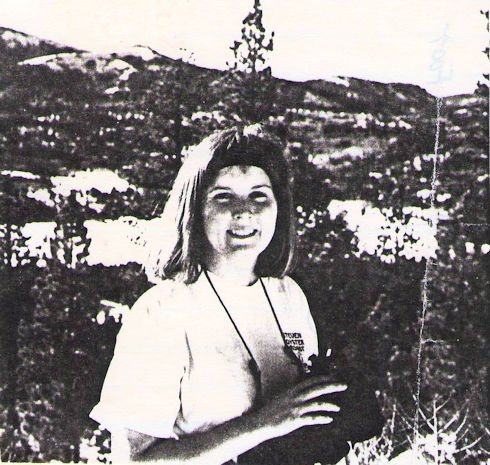
Carol L. Russell
April 9, 1004 - Female missing from Marine Housing Compound
Carol L. Russell, 29, was reported missing from the Marine Corps Housing Compound. A long and tedious search-and-rescue had a very satisfactory ending. Ten June Mountain Search and Reascue members, with WOOF dog Trapper, joined with 100 U.S. Marines, two naval helicopters, Fish and Game workers and four other dogs. The missing woman was finally spotted by a helicopter at about 4 p.m.
She had gone for a walk, apparently become disoriented and wandered some distance in the wrong direction, but was found unharmed and is currently recovering. Russ Veenker stated that, even with the large number of searchers, it was very well organized.
April 14, 1994 - Rock Rescue Training with Marty Burgenbauch 5 PM at Triple Cracks.
April 18, 1994 - Dry Land Scuba Training for scuba certified divers at 3 PM at Veenker's in June Lake.
April 19, 1994 - Bouldering practice with Greg Enright 5 PM at Middle Gorge.
April 21, 1994 - Tracking Training with Larry Ford 6 PM at Rattlesnake Curve (midway up Conway Summit).
April 23, 1994 - Search Training with Greg Enright 9 AM at Smokey Bear Flat.
April 26, 1994 - Search practice 5 PM at Smokey Bear Flat.
Sallee Burns and Trapper are now a certified Search Dog Unit, having recently passed the test at a site north of Truckee. They are on call from a wide area, and are dispatched by requests through the Marin County Sheriff.
Becky Bittner completed her EMT training, and Julie Stelman (a.k.a. Wichelmann) completed her EMT re-certification.
May
May 10, 1994 - Swift Water Training with Larry Ford at 9 AM. Location will be announced by callout.
May 12, 1994 - Low Angle Litter Training with Long Valley Fire Department. Meet at 7 PM at the fire station. Training site will be in Lower Rock Creek Gorge.
May 17, 1994 - Training - Global Positioning Systems
From Review-Herald newspaper report by Kelli Du Fresne:
Rescue team goes into orbit for help Traveling into the back-country can be a very beautiful experience until you break your leg.
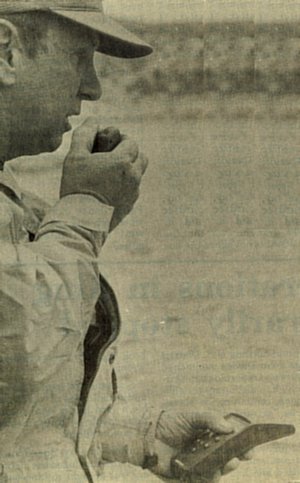
June Lake Search and Rescue Training Officer Don Little holds one of the new GPS units the team will use on their rescue missions
While the scenery is just as beautiful with a broken leg, one's ability to appreciate the beauty may be marred by shooting pain. Nature's beauty may also lose some of its charm when the sun goes down and it gets cold and things go bump in the night.
For search and rescue teams, the dark presents these along with different problems. When voyaging into the backcountry along well marked trails at high noon, it's easy to stay on track. On a dark night with no moon, it's not so easy. It is also not so easy to find a fallen climber at the bottom of a canyon.
The June Lake Search and Rescue Team has purchased two new gadgets to help them in their searches. They are called GPSs, or Global Positioning Systems.
GPSs work with 24 fixed-orbit satellites to help locate rescue team members.
If teams are sent out in five directions and one team finds the victim, the other members still searching may need to meet up with the discovering team.
The GPS units allow the teams' positions to be pinpointed and provide a complete set of directions for finding each other.
The GPSs are hand-held units about the size of a transistor radio. They can tell the longitude and latitude of the person who is holding the unit and it can be programmed to plot a path back to a certain goal.
In a training exercise held on Tuesday, May 17, 1994, the search and rescue team utilized a California Highway Patrol helicopter and crew to help test the GPS's accuracy.
From the middle of Crowley Lake, the unit received signals from five satellites and located the longitude and latitude of the Mono County Sheriff's Department boat. That information was then relayed by radio to helicopter pilot Merrill Gracey, who then tracked the boat using another GPS unit held by team member Jim Gilbreath.
The units proved to be accurate within 300 feet. From the middle of the lake, team member Don Little then programmed a goal of Mammoth Lakes Airport. The GPS told him that at 4 mph, it would take him 20 minutes to reach the airport. It told him what day it was, what time it was and what time it would be when he reached the airport. The unit also told him what compass direction to follow.
One team member said, "It does everything but make coffee."
Because of the inclement weather, testing the GPS could not be done in the backcountry. Mono County Sheriff's Officer Doug McGee said the units may not work in the bottoms of deep canyons where even the team's hand-held radios do not work, but that the systems cut out many steps in locating rescue team members. "They will be a great asset to the team," McGee said.
The systems cost $735 each and will run for four to six hours continuously on four AA batteries.
Mono County has purchased two units for the team's use and Little recommended that the team have a minimum of eight systems.
McGee left on Tuesday morning to look into purchasing one more unit and battery packs with county money. The search and rescue team also voted to purchase three units with their own money. This would bring the number up to six within a couple of weeks.
The GPSs replace the old-fashioned triangulation method of pinpointing positions using land marks that are not always visible in the dark or during bad weather.
The county's funds for the search and rescue team are budgeted each year. Little said most of the team's funding for technical equipment, like their climbing gear and radios, comes from donations. The team will be looking into gathering corporate sponsorships in the near future.
The CHP helicopter crew also included Flight Officer Kelly Richardson, who also acts as a paramedic. The helicopter crew is based in Barstow and flew 2 hours and 40 minutes to give the search and rescue team an orientation on working with the helicopter.
"We will help in any which form or shape is needed," Richardson said. Her partner, Gracey said, "Don't be bashful about calling us."
May 19, 1994 - GPS Receiver Training with Jim Gilbreath at 5:30 PM at Smokey Bear Flat. Bring your pocket tape measure and an Old Mammoth map if you have one.
May 26, 1994 - Orienteering Training at 5 PM at site northwest of Crowley Lake BLM Campground.
The search and rescue of Carol Russell has resulted in several fine letters of commendation and thanks from the Marine Corps for Russ Veenker and the team.
June
June 9, 1994 - Low Angle Litter Training with Long Valley Fire Department at 7 PM at the Fire Station.
June 13, 1994 - Radio Training with Shawn Moats at the Mono 2 Substation at 7 PM.
June 14, 1994 - Dive Training with Larry Ford, at 9 AM at June Lake Beach.
June 14, 1994 - The first in a course of six Stretcher Training sessions, extending into July, with Greg Enright at 5 PM. All on Tuesdays, all at 5 PM. The first is basic stretcher, basic knots, and rappelling, at Deadman Summit on the west side of 395.
June 16, 1994 - Helicopter Training with the Navy team from Fallon, Nevada at 10 AM at Mammoth Airport.
June 18, 1994 - Annual Field Testing for everyone at 9 AM. at Inyo Craters. Pack layout, Tracking (identify & preserve track, draw track on report, find & mark next ten tracks w/stick), Search (search 10 meter X 100 meter area for 10 cards), Basic Knots (8, 8 on a bight, overhand in webbing, prusik, no-knot), Rappel down side of crater (use of harness & figure 8 descender), Climb up side of crater (class 3 belayed), Orienteering (follow short course, map & compass proficiency), Physical Conditioning (climb Deer Mountain SE ridge & return).
June 21, 1994 - #2 in the Stretcher course with Greg Enright at 5 PM. Lowering and rappelling, at the falls 150 yards below the outlet of Twin Lakes (Mammoth), on the south side of the creek.
This turned into a rescue of one of the students as described by Jim Gilbreath:
We parked the van on the shoulder of Lake Mary road below the dam, and took all the gear down a steep slope to the cliffs on the north side of the creek. Though the first day of summer and a beauty, the wind was brisk and steady, so it felt cold right away, and got colder as darkness approached.
The theme for the night was lowering. We practiced setting up all the anchors and belays and braking systems and then the designated victim rappelled down to a ledge about halfway down the overhanging cliff and got himself "stuck" and cried for help.
This is a situation that happens once in a while where you have a victim who is "sound", but cannot help himself. A team member then got lowered over the cliff and down to the victim, tied him into the lowering and belay ropes using various methods, and then got both lowered together down to the bottom.
Part of the training was for each of us to rappel down the cliff. I did the rappel just fine. After climbing back by way of a nearby gully, I got busy rigging a rope for another exercise, and only casually noted that Howard Hilliard was next to rappel. He went over the side and made a lot of frightened noise, and soon there was a loud shout that "we have an injury".
He got a bad start and went sideways then upside down and bumped the wall with his back. He was in a lot of pain, and was hanging onto the rope real tight. Don Little had to convince Howard to turn loose so he could be lowered down to the bottom of the canyon using tension from below on the figure eight descender. That went smoothly, but Howard couldn't stand or walk, and a serious injury had to be suspected.
We got Medic 3 called first, then the Mammoth fire department to provide muscle for the raising operation. We only had ten people, and that's not enough to do everything. The van was way up on the road, and we had to get some equipment down - Stokes litter, sleeping bag, etc. Fortunately we already had all the technical gear needed with us.
Pete Schoerner arrived quickly with Medic 3 van, and went down to check out the victim. He thought there was no skeletal damage and the main thing was muscle stretch and spasm, but called for the backboard and C-collar due to the pain level.
While this was all coming down, we got busy rigging the hauling system pulleys and belays for the main pull out of the gorge, while the fire department rigged a hauling system for the last pull up to the road.
After waiting in the cold wind while everything got set up, we got started pulling Howard in the litter and its big wheel up the gully, with six guys climbing and stabilizing it over the rocks. This is really hard work. We had four very strong firemen to help Shawn Moats and me to pull at the top.
The terrain to the top of the gully was sage and manzanita and not steep enough to need any rigging, but the six guys on the litter had a lot of work to do. The steep last pull up to the road went quickly with lots of firemen pulling on the 2:1 pulley system. Howard was kept on the backboard when transferred to the medic van and taken to the hospital.
When contacted the next day, Howard reported that he got out of the hospital about 0230 after a lot of X-rays. They found nothing broken, just a lot of muscle trauma from spasm. He was pretty sore and uncomfortable, but happy. His view was that this may have been a good thing for everyone - a lesson for him in what NOT to attempt, and good training for the team.
From Review-Herald newspaper report by Jason Montiel
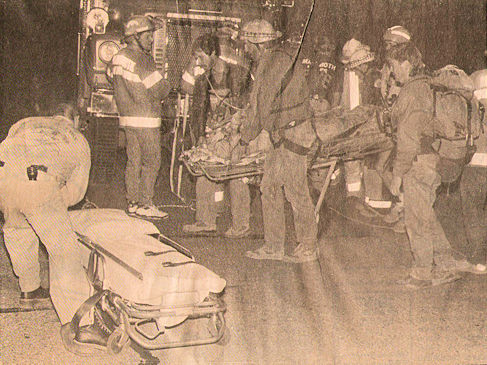
Members of the Mammoth Lakes Fire Department and Mono County Sheriff's Department Search and Rescue wrap up rescue procedures on Howard Hilliard on Tuesday
Rescuer is subject of cooperative rescue
A search and rescue team candidate had to be rescued on Tuesday night after he got into a precarious position during a training exercise on a cliff near Mammoth Creek just downstream from the Twin Lakes outlet.
The rescue effort, which closed Lake Mary Road for about an hour beginning at approximately 9:25 p.m., was cited by Mammoth Lakes Fire Department Assistant Fire Chief Marty Larson as a good cooperative effort between his department and Mono County Sheriff's Department Search and Rescue.
Howard Hilliard, of Mammoth Lakes, training to work on the search and rescue team, was completing a rappelling maneuver down a cliff in which he needed to keep his feet below his head as he made his way past the lip of the cliff.
In the process, however, his feet got above his head and he swung into the rock wall below, slightly injuring his back. He then had be lowered down the cliff.
Hilliard was never in danger of falling, thanks to a belay system that was in place.
"It was a litter training exercise required for all candidates," said Doug Magee, search and rescue coordinator for the Sheriff's department.
Through the cooperative efforts of the fire department and search and rescue team members, Hilliard was placed on a litter, carried through heavy brush and up steep terrain to Lake Mary Road where Medic 3 was waiting to transport him to Centinela Mammoth Hospital for an x-ray and examination.
Magee said Hilliard is now "in great shape."
June 23, 1994 - Van Training at the Mono 2 Substation at 7 PM.
June 28, 1994 - #3 in the Stretcher course with Greg Enright at 5 PM. Victim Tie-in and rappelling, at Hole in the Wall. Meet at the Horseshoe Lake parking area.
Blood Borne Pathogen Training is a new requirement for ALL of us. You must attend one of the following two-hour sessions:
June 29, 1994 at 10-12 AM or 2-4 PM at Memorial Hall in Bridgeport.
June 30, 1994 at 10-12 AM or 2-4 PM at Justice Court in Mammoth.
June 30, 1994 GPS Receiver Training and proficiency testing for Ops Leaders and others with current experience with the Trimble Scout receivers; with Jim Gilbreath at 7 PM at Shady Rest.
Don Little's proposal to change the team's name, logo, and letterhead was approved at the June meeting. We are now the Mono County Sheriff Search and Rescue Team.
July
July 6, 1994 - Human remains found in field
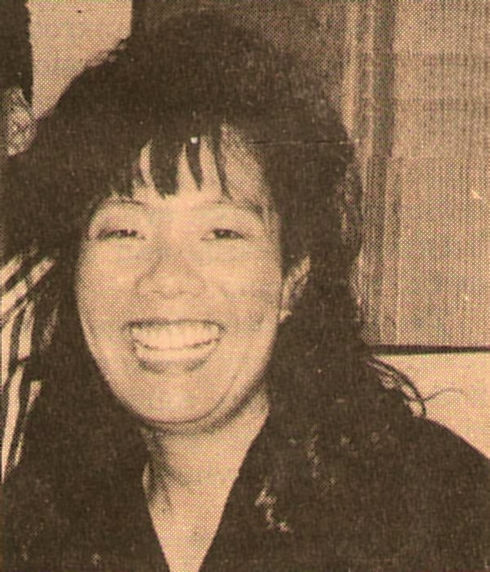
Shirley Hitomi Koga
From Review-Herald newspaper report by Kimberlee Noll
Equipped with brown paper bags, plastic bags and surgical gloves, three law examined the remains of a human body found behind the Minaret Village Mall yesterday.
The remains, not yet known to be male or female, were found Wednesday afternoon by two boys hiking in the vacant field across from Mammoth High School on Meridian Boulevard.
"Shortly after noon, two youths found a skeleton near a manzanita bush off of Meridian," said Mammoth Lakes Public Information Officer Jeff Irons. "They called the police department, who then called the Mono County coroner who determined the remains to be human."
Irons added that Coroner Steve Maris gave some indication that the body had been at the location "for some time."
Because the remains are in such poor shape, the body will have to be identified through dental records and a forensic investigation.
While the police are not certain whose body the boys discovered, they are investigating the possibility that the body could be that of Shirley Koga, a Gardena resident who disappeared during a vacation in Mammoth Lakes on December 11, 1990.
"The police are not confirming that this is who it is," Irons stated. "it is just a starting point because she is the only person left on the police department's books."
July 8, 1994 - Search for remains ends, dental records arrive soon
From Review-Herald newspaper report by Kimberlee Noll
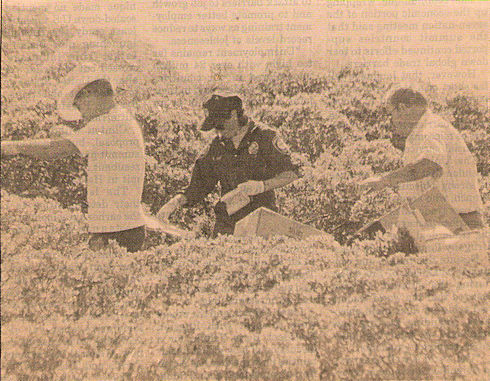
The Mammoth Lakes Police Department and the Mono County Sheriff-Coroner's Office were called out to recover human remains found behind Minaret Village Mall on Wednesday. Doing the initial search on Wednesday, from left to right, are Sgt. Deputy Chief Coroner Steve Maris, Detective Karen Smart and Deputy Investigator John Rutkowski
On Friday, the Mammoth Lakes Police Department and the Mono County Coroner's Office ended their search for additional human remains and requested the dental records of Shirley Koga to use in the possible identification of the human skeleton found behind Minaret Village Mall on Wednesday.
According to Sgt. Chief Deputy Coroner Steve Maris, these dental records could be instrumental in determining whether or not the skeletal remains are that of Koga, a Gardena, Calif. resident who disappeared during a vacation in Mammoth Lakes in December 1990.
"We did recover a skull with a portion of the upper and lower jaw and teeth," Maris said. "And, in terms of the ability to identify the body, the recovery of the skull is most important."
Koga's dental records were sent for because she is the only known missing person in our area who has never been recovered.
Once the dental records arrive, which according to Maris should be early this week, they will be sent along with the skull to Dr. Ed Bulpitt, a dentist in Bishop.
"Once we get the records and Dr. Bulpitt has a chance to compare them to the skull, we should know if in fact it is the young woman within a day or so," Maxis said.
In addition to the skull, a portion of a fragmented leg bone was found, as well as some small, unidentified bone fragments and material believed to be clothing.
"We feel we've done the best we could in sweeping the area," said Karen Smart, Mammoth Lakes Police detective and lead investigator on the case.
The search of the area, located approximately 100 yards southeast of the intersection of Meridian Boulevard and Sierra Manor Road behind Minaret Village Mall, was completed in three days.
On Thursday, Mammoth Lakes police officers, sheriff deputies and 10 members of the Mono County Sheriff's Department Search and Rescue Team performed a grid search to ensure that nothing was missed from Wednesday's area investigation.
"A grid search is a more organized effort to gather every small piece of evidence that is related to the scene," said Mammoth Lakes Police Lt. Mike Donnelly.
In a grid search, string is placed in rows and cross-rows, which defines a small area that more easily can be extensively searched for evidence.
If within that area anything considered unnatural or out of place is found, it is evaluated for its evidentiary value and bagged until officials are certain it is not part of the case.
We couldn't have done such an extensive search without the help of the search and rescue team," Smart said. "They volunteered eight hours out of their day to help us and they really did a super job."
As to the cause of death or the circumstances surrounding the death of the person whose remains were found, Maris said that perhaps no one will ever know what happened.
"Without tissue or internal organs the circumstances or causes may never be known, unless we found a bone with some identifiable mark," he said.
If the remains are determined to not be those of Koka, an anthropologist will be called in to examine the bones and try to determine the sex, approximate age and race of the remains.
The remains were found by two boys hiking in the field behind Minaret Village Mall on Wednesday afternoon.
July 12, 1994 - Remains proven as those of Koga
From Review-Herald newspaper report by Kimberlee Noll
The human remains found behind Minaret Village Mall last week were positively identified as those of Shirley Koga, a Gardena, California resident who had been missing from the Mammoth Lakes area since December 1990.
Dr. Ed Bulpitt, a forensic odontologist in Bishop, compared Koga's dental records with portions of a skull that was discovered underneath manzanita brush on July 6 by two boys 'hiking through the vacant field off of Meridian Boulevard and Sierra Manor Road.
Bulpitt concluded his examination on Tuesday afternoon.
"The missing persons case is now closed with the Gardena police department, but investigations continue as to the cause of her death," said Jeff Irons, public information officer for the Town of Mammoth Lakes.
According to Sgt. Chief Deputy Coroner Steve Maris, the remains are now being examined by Dr. James Tenney to determine the cause of death. Tenney is a forensic pathologist in Bishop.
After the remains were initially found, officers from the Mammoth Lakes Police Department, Mono County Sheriff's Office and members of the Mono County Search and Rescue Team performed a grid search in the surrounding area hoping to find clues as to the identity of the remains and the cause of death.
Their search, which uncovered bone fragments and material believed to be clothing, was completed on Friday.
July 12, 1994 - The completion of the rock rescue stretcher series with Greg Enright at 5 PM. Stretcher Tie-in. Meet at the Horseshoe Lake parking area.
July 18, 1994 - Missing hiker overdo from Duck Lake area. He came out of Valintine-Sherwin Lakes drainage. Team had searched toward Duck Lake up to Barney Lake when the search was called off.
July 20, 1994 - Dive training. Meet at 9 AM at the stash at June Lake Fire Department - diving planned at Gull Lake.
Public Relations. We will show the van and answer questions at the Mono General Hospital Health Fair in Bridgeport on Sunday July 23.
July ??, 1994 - Two bodies found near June Mountain
From Review-Herald newspaper report by Kelli Du Fresne
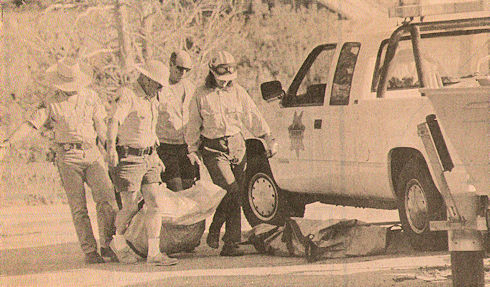
A hiker in the backcountry near June Moutain discovered a plane crash with two bodies on Friday. Because the crash site was surrounded by steep mountains, the bodied had to first be transported out by helicopter
Two unidentified bodies were discovered in the front half of a crashed airplane by a hiker in the Ansel Adams Wilderness on Friday morning.
The two bodies, one male and one female, were discovered by a hiker from Fair Oaks, California who had been camped at Alger Lakes.
The crash site is located 6.1 miles from the June Mountain parking lot on the west side of Blacktop Peak, according to the Global Positioning Systems used by the Mono County Sheriff's Search and Rescue Team.
The aircraft has been identified as a 1984 Mooney, low-wing, single-engine, four-passenger plane.
Because of the number of different agencies involved in the initial missing persons reports on the two victims, neither the victim's identities nor the exact flight plan of the aircraft could be determined by Mono County Sheriff's personnel at press time.
Reports are that the two have been listed as missing since mid-November or December 1993, but sources could not confirm that information.
Forms of personal identification, including a wallet and two brief cases, were found in the plane. However, Sgt. Chief Deputy Coroner Steve Maris said additional information must be obtained before positive identification of the victims can be made.
"We have some idea of who they are," he said. "The information gives us a starting point. Something to go on. But we have to be absolutely certain."
Maris also said that the victims most likely died instantly.
The front portion of the aircraft is mostly intact. However, the tail section is missing and could not be found by the Sheriff's reconnaissance team or from the air by the Inyo National Forest's Helitack 525 helicopter team who aided in the extrication and search.
The bodies were removed from the scene and transported to Brune and Buck Mortuary in Bishop for identification and forensic purposes.
Search and rescue team member Russ Veenker said that the plane's Electronic Locating Transmitter was intact and connected. The plane is severed behind the rear baggage door just behind the back seats.
The wreckage is sitting on a plateau near the Mono/Madera county line at the 12,000-foot level west of Blacktop Peak and is surrounded by severe dropoffs. Sheriff's deputy Hap Hazard said debris was scattered throughout the area.
July 24-25, 1994 - Hiker climbing Mt. Morrison has fatal fall. - A hiker climbing Mt. Morrison fell on the way down and died. Mono County Search and Rescue Team and Long Valley Fire paramedics conducted a search on very steep terrain. The victim was extracted by helicopter the next day.
July ??, 1994 - Injured hiker near Shamrock Lake - The team responded to a man with a broken ankle about three miles in behind Saddlebag Lake near Shamrock Lake. The 230lb subject was carried out to the trailhead.
August
August 8-10, 1994 - Missing hiker Leavitt Lake/Tower Peak area
From Review-Herald newspaper report by Kelli Du Fresne
County search team looks for missing hiker
The Mono County Sheriff's Search and Rescue Team was called out Monday afternoon to search for a missing hiker in the area between Leavitt Lake and Tower Peak near Sonora Pass.
Searchers are looking for Jerry Paul Dragoo, a 48-year-old white male, from Taft, California who was called in as missing when he failed to meet up with friends on his exit date Sunday, August 7.
Dragoo's car was found parked at the Leavitt Lake trail head late Monday afternoon. Searchers are now searching his proposed route. On Wednesday, the search was concentrated in the Sister Lakes area.
In addition to the Mono County rescue team, two Woof Teams of dog trackers, a team from the U.S. Marine Corps base at Pickel Meadow, Kern Search and Rescue, Fresno Search and Rescue, the Nevada Air National Guard, CARDA rescue dogs, Yosemite National Park and a California Highway Patrol helicopter crew are also aiding in the search.
Rescuers find man near Helen Lake
Jerry Paul Dragoo, a hiker missing since last Sunday, was found Wednesday afternoon south of Helen Lake, in the Toiyabe National Forest between the "Sister Lakes" and Tower Peak, said Mono County Sheriff's Search and Rescue Coordinator Doug Magee.
The search began late Monday afternoon when Dragoo's car was found at the Leavitt Lake trailhead and officials determined that he was still in the backcountry.
Searchers began searching Dragoo's proposed route between Leavitt Lake and Tower Peak on Tuesday.
Searchers on Wednesday concentrated their efforts in the "Sister Lakes" area and located Dragoo at about 2 p.m. south of Helen Lake.
Dragoo suffered multiple abrasions, cuts and broken bones due to a fall. The exact date of the fall was unknown at press time.
Dragoo was flown to Washoe Medical Center in Reno, Nevada by the California Air National Guard.
Dragoo is a school superintendent from Taft, California who was listed as missing when he failed to rendezvous with friends Sunday, August 7.
In addition to the Mono County rescue team and the California Air National Guard, two teams of Woof dog trackers, a team from the U.S. Marine Corps base at Pickel Meadow, Kern Search and Rescue, Fresno Search and Rescue, the Nevada Air National Guard, CARDA Rescue Dog teams, Yosemite National Park and a California Highway Patrol helicopter crew assisted in the search.
Team Picnic: The annual team picnic is tentatively scheduled for Sunday August 14 at June Lake Beach. Mark your calendar.
August 15, 1994 - Search and rescue team remembers a lost member
From Review-Herald newspaper report by Kelli Du Fresne
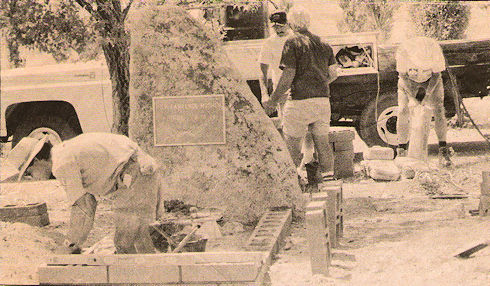
In respect for the memory of a former search and rescue team member who died on a search mission, members of the current team made improvements on Rick Lawrence Mosher's grave site last Monday. Pictured above are from left to right, Pete Schoerner, Cole Hampton, Jim Collins and John Ellsworth.
On August 15, 1979, an Inyo County Sheriff's plane crashed during a search for three hikers that were overdue in the Convict Lake drainage area.
The plane carried the pilot, Investigator James Randolph, 37, of Bishop and a June Lake Mountain Rescue Team member, Rick Lawrence Mosher, 29, who were both killed instantly when the plane crashed into a peak in the Convict Lake area.
In memory of June Lake Mountain Rescue Team member, Mosher, the Mono County Sheriff's Search and Rescue Team spent Monday making improvements to Mosher's grave site.
Rescue team member Pete Schoerner noticed that the grave was looking run down and decided that the 15th anniversary of Mosher's death was a good time to make the improvements and recognize the loss of a team member.
Schoerner, John Ellsworth, Cole Hampton and Jim Collins spent Monday at the Mono Lake Cemetery building a short, cinder-block wall along the outline of the grave.
Ellsworth said that on August 15, 1979, the June Lake Mountain Rescue Team was called out to find some overdue hikers in the Convict Lake drainage area. Ellsworth, Mosher, Schoerner, Steve Gold and a number of others responded to the search.
After the plane left on the search, little information was reported back by the searchers. Reports soon came back that the plane had crashed. Ellsworth and Schoerner then went to find the plane in a helicopter.
The saddest part about the search is that Mosher's wife was on scene at the search when the crash report was made.
Ironically, the hikers walked out of the backcountry and said that a mistake had been made and they were not late.
September
September 19, 1994 - Rock Rescue Training (Anchoring 101) with Doug Nidever at 5:30 PM. Meet at June Lake Fire Station. This training is primarily for those already experienced in rock rescue, but others are welcome to watch.
Congratulations and welcome to Sam Lalande, who completed his training requirements and was elected to MEMBER status at the September meeting.
Letters: The team received a fine letter of thanks and appreciation from Gerry Dragoo (the victim in the Tower Peak area search and rescue August 9). He is recovering nicely from his injuries. The surgery on his broken ankle went well, and he expects to recover fully. He is so impressed with our good work, he wants to become involved in search and rescue himself and help others.
We also got a letter of thanks and a contribution from his friend Steve Furtney, who was a lot of help to us at the EOC during the operation.
The new logo patches, shirts, and hats are available from Dan Wright (hats, patches) and Joe Rousek (shirts) at the following prices: Shirts - $13, hats - $7, patches - $3.50.
November
The annual election of the team's officers was held at the November Meeting. Thanks are due to Russ Veenker, Shawn Moats, and Don Little for their work as the nominating committee.
Dan Wright will serve a third term as President, made possible by the temporary set-aside of a bylaw for one year. Julie Stelman is the new Secretary. Joe (and Ann we suspect) Rousek is the new Treasurer. Training officers are Greg Enright, Steve Case, and Mike Soler. Equipment officers are John Estridge, Karl Chang, and Mike Yost. Vice President is Jim Gilbreath (who feels like a Seaman Recruit that got selected for Rear Admiral).
The team expresses thanks and appreciation for the dedication and high performance of the retiring officers, Sallee Burns, Don Little, and Shawn Moats.
Welcome to newly approved Candidates Mark Busby, Ray Glenn, and Marjorie (Skip) Lowry.
December
December 12, 1994 - Winter Travel Skills Training with Pete Kirchner
December 14, 1994 - Avalanche Transceiver Training with Gary Guenther